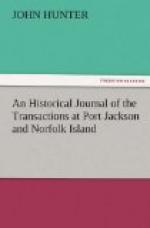On the 24th, the wind shifted to the eastward, and the weather was more moderate, but on the 27th, it again got to the westward, blowing strong, and in violent squalls, attended with snow and hail. A great number of albatrosses, blue petrels, and sheerwaters were about the ship; a high, irregular sea caused her to labour much, and she made a deal of water in her topsides. The latitude, at noon, was 57 deg. 32’ south, and 245 deg. 42’ east longitude. On the 29th, the longitude, by the time-keeper, was 259 deg. 16’ east, and by account 256 deg. 50’ east; at the same time the latitude was 56 deg. 30’ south. The wind was still to the westward, attended with very heavy rain. In the morning of the 31st, the wind blew strong from the northward. Great numbers of gulls were about the ship, and we passed a deal of rock-weed.
During the 1st and 2d of January, 1792, the wind was variable, frequently shifting from north-north-west to west-south-west and south-east by east. At noon on the 3d, we were in 56 deg. 15’ south latitude, and 281 deg. 57’ east longitude. The next forenoon, we saw a seal, and had a number of albatrosses about the ship: we now had strong gales from the north-east quarter, attended with snow and sleet. A heavy squall came on in the morning of the 5th, and in hauling down the main-top-mast staysail, the brails broke, and the sail was blown in pieces, the greatest part of which fell overboard before it could be got down and stowed.
In the afternoon, we saw several gulls, a seal, and some shell-drakes. At noon on the 6th, we saw Cape Horn, bearing west-south-west half west, and the northernmost land in sight, west half south, distant six or seven leagues. At that time, our latitude was 56 deg. 02’ south, and the longitude 291 deg. 45’ east. At eight o’clock in the morning of the 7th, we saw Staten Land, bearing from north by west to north-west by west half west, twelve or thirteen leagues distant: at noon, the north point bore north, a little westerly, distant about eight leagues. In the afternoon, several whales were seen near the ship, the body of Staten Land then bore south-south-west. The wind, which for some days had been to the southward, shifted, in the morning of the 8th, to north-west, with a moderate breeze and fine weather. In the afternoon, we passed some pieces of sea-weed, amongst which was a seal; we also saw another seal and some penguins: several whales and large flocks of blue petrels were about the ship. The next forenoon, we passed some sea-weed and a number of penguins; on which we sounded, but got no ground with 100 fathoms of line. Our latitude, at noon, was 52 deg. 58’ south, and longitude, by the time-keeper, 296 deg. 13’ east. We sounded again in the evening, but got no ground with 145 fathoms of line. At midnight, we had a calm for about two hours, the weather thick and foggy, with thunder and lightning to the southward.




